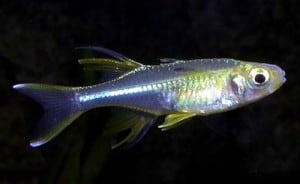
Common name: Celebes Rainbowfish
Scientific name: Telmatherina Ladigesi
Average Adult Fish Size: 3 inches / 8 cm
Place of Origin: Indonesia
Typical Tank setup: Celebes Rainbows are a very popular aquarium fish, and don’t require anything special. A peaceful community aquarium. Rainbows would ideally be in a planted tank. When housing Celebes Rainbow’s in the home aquarium it is important to provide them with a long (4 feet or larger) aquarium that has areas of plants and plenty of room for these active swimmers to move about. They are also well known jumpers, thus their aquarium should be well covered in order to keep them from jumping out of the aquarium when startled.
Recommended Minimum Aquarium Capacity: 55 gallon / 240 litre
Compatibility: Peaceful community tank mates like Molly’s, Guppies, Plat’s and Tetra’s.
Temperature: 23 – 32 Deg C / 73 – 89 Deg F
Water chemistry: pH 4.5 – 7.5
Feeding: The Celebes Rainbow fish should be fed once or twice a day. It is very important not to over-feed your Rainbow. All food should be consumed after just a few minutes. If not, you are feeding your Rainbow to much food in one serving. You can buy flake food specially made for tropical fish, such as the Rainbow in your fish store. A flake food diet is a good base for the Rainbow, but should ideally be supplemented with live food. Your Rainbow will survive on flake food alone, but the live food makes the Rainbow more well-nourished and healthier. Live or frozen Brine Shrimp is a popular Rainbow fish food since Brine Shrimp is very easy to produce at home. Bloodworms, Micro Worms, Fruit Flies, Mosquito larvae, Daphnia and chopped up Earthworms are other examples of suitable food for your Rainbow.
Sexing: Males are the more colourful sex and develop beautiful extensions to the second dorsal and anal fins.
Breeding: Rainbow’s deposits its eggs in vegetation or other suitable substrate with Java moss. It’s best spawned in a pair or group comprising a single male and two or three females in a tank measuring 50-60 cm long.
Females are capable of covering some large, vigorous eggs per day and the adults can either be added to the spawning tank and left in place for a week or so, until the first fry are noticed, or the substrate can be checked each day and eggs removed manually. Males can be aggressive in their pursuit of females keep a look out when on the fish while they’re housed in these confined surroundings, and try to provide some solid cover using large-leaved plants or wood.
Additional Information: For many years, this species was included in the genus Telmatherina, and is still listed as such in much of the available literature. In fact it’s now the only species in the recently erected genus Marosatherina. Unfortunately, it has been over fished for the aquarium trade in its native waters and is listed as ‘vulnerable’ on the IUCN red list of threatened species. Thankfully, it’s now being mass-produced on fish farms in both the Far East and Eastern Europe, meaning that fewer wild caught specimens are available as a result.


Related Posts
Croaking Gourami – Trichopsis vittatus
Benthochromis Tricoti
Large-eyed Mouthbrooder – Callochromis Macrops